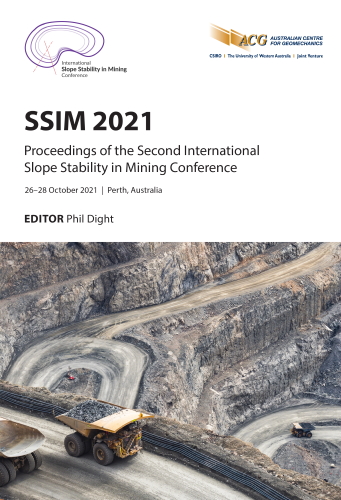Improved prediction of runout distance for in situ highwall instability in Australian eastern coast coal mines

|
Authors: Nairn, L; Della Pasqua, F; Payne, D |
DOI https://doi.org/10.36487/ACG_repo/2135_32
Cite As:
Nairn, L, Della Pasqua, F & Payne, D 2021, 'Improved prediction of runout distance for in situ highwall instability in Australian eastern coast coal mines', in PM Dight (ed.), SSIM 2021: Second International Slope Stability in Mining, Australian Centre for Geomechanics, Perth, pp. 501-512, https://doi.org/10.36487/ACG_repo/2135_32
Abstract:
The non-homogenous and often insufficiently characterised nature of rock slopes requires mining geotechnical engineers to ensure that pit design is supported by appropriate operational controls. The consequences and near misses from recent large open pit slope failures (>500 m3 failed volume) have driven industry bodies to further refine the delineation of wall failure runout distances. In managing failure hazards, a standoff distance is typically determined by the prediction of potential failure mechanism, volume, and runout distance. Accurate prediction of the runout distance is critical to mine operations for safety and economic reasons. Whilst a comprehensive dataset and research history exists for slope runout predictions in environments such as rock avalanches, landslides, and natural debris flows, similar work directly applicable to the open cut coal mining industry is in its infancy. In particular, the travel angle, or Fahrböschung angle, is a well-recognised relationship that has been used for excavated slopes but is not commonly applied to open cut coal slopes less than 100 m. This investigation has taken the opportunity to gather and interpret new data points from historic failures to improve the accuracy of runout distance predictions. The new dataset included over 50 additional historic open cut highwall failures from eight open cut coal mines situated across the Bowen Basin and the Hunter Valley. Systematic characterisation of runout distances was based on geotechnical parameters such as in situ wall failure height, floor dip, slope angle, failure mechanism, volume of failed material, and geotechnical domain. Through detailed analysis, this new dataset has been statistically evaluated and showed comparable results to previously published data, including the coal industry specific slope stability assessment methodology (SSAM) tool, as well as new empirical trends. Additionally, the investigation has considered initial works for a Fahrböschung angle relationship. This database can be used as a proactive tool to inform failure run out predictions, and also to ensure learnings and data from past failure history is captured and used by the next generation of geotechnical engineers without having to experience past failures.
Keywords: runout distance, standoff, highwall failure, coal mine, Fahrböschung angle
References:
Maptek 2021, Maptek Vulcan, version 2020.2, computer software, Maptek Pty Ltd, https://www.maptek.com/products/vulcan/
McQuillan, A 2019, A Risk-Based Slope Stability Assessment Methodology (SSAM) for Excavated Coal Mine Slopes, PhD thesis, The University of New South Wales, Sydney.
Okada, U 2013, ‘Dependence of runout distance on the number of rock blocks in large-scale rock-mass failure experiments’, Journal of Forest Research, vol. 19, issue 3, pp. 329–339.
Resources Safety and Health Queensland 2020, Queensland Mines and Quarries Safety Performance and Health Report 2019-2020, Queensland Government.
Whittall, JR 2009, Runout Exceedance Prediction for Open Pit Slope Failures, PhD thesis, The University of British Columbia, Vancouver.
Whittall, J, Eberhardt, E & McDougall, S 2017a, ‘Runout analysis and mobility observations for large open pit slope failures’, Canadian Geotechnical Journal, vol. 54, no. 3, pp. 373–391.
Whittall, J, McDougall, S & Eberhardt, E 2017b, ‘A risk-based methodology for establishing landslide exclusion zones in operating open pit mines’, International Journal of Rock Mechanics and Mining Sciences, vol. 100, pp. 100–107.
© Copyright 2025, Australian Centre for Geomechanics (ACG), The University of Western Australia. All rights reserved.
View copyright/legal information
Please direct any queries or error reports to repository-acg@uwa.edu.au
View copyright/legal information
Please direct any queries or error reports to repository-acg@uwa.edu.au